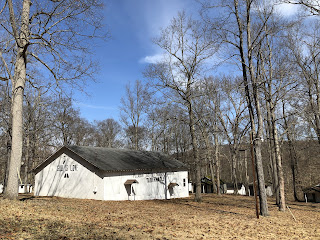This is Limestone Road in Tucker County, West Virginia, near the village of St. George. It doesn't look all that scary in this photo, but I was sure glad I didn't meet any traffic coming the opposite direction when I had that steep drop off to my right. It's about as wide as most driveways.
I spent my day off scouting out some West Virginia properties I found for sale online. One of them was less than $6,000 and I quickly found out why. Despite having a nice stream running through it and the foundation of an ancient mill, the lot was right inside a dumpy little hamlet with messy neighbors crowding in on both sides. Decaying cars in the yards. You'd have to plant a very tall barrier of evergreens to block the eyesores on both sides, and who knows what kind of noise? Worst of all, the lot shares a driveway with one neighbor--apparently a Harley owner. Not the bucolic retreat I'm looking for. This, however, this steep bit of hilly woods is exactly what I want.
A steep, sequestered acre and a half of woods adjacent to the Monongahela National Forest in northern West Virginia. I like the sharp grade of the land. I'd love to delve into the hillside to carve out a sort of "earth ship" with all the protection from heat, and cold, and wind that semi-underground living affords.
I recall as a kid in the poor areas north of here that many families constructed their basements first, then never got around to putting houses overtop of them. Basement homes. It could be lovely, with a big wall of windows facing the road and a garden and sitting area on top of the earthen roof. There's a pleasant stream just across the road and so little traffic passes on this narrow road. This plot is selling cheap, but it would require a septic tank, and a well, and a lot of excavation--which would add up. I'm 13 years from retirement and I feel the need to plan wisely.

A part of me feels hopelessly selfish--knowing that the people of Ukraine also have their dreams and hopes for retirement and secluded getaways. How can I allow a selfish venture like this to occupy my energies when their lives are entirely upended? But truly, as much sympathy as I have for the Ukrainians--and I have a lot--I wonder why their lot should upset me any more than that of the Syrians and Afghanis? I have managed to be happy during their sufferings, haven't I? God forgive me, there's surely an element of implicit racism in all of that. I don't want it, but there it is. In any case, their lot may be mine someday. Let me smile whilst I may. Besides, hoping for things is often better than attaining them--and hopes may be as far as I get with this desire for a cabin. West Virginia is a lovely woodland escape for me, but the towns down there all have a shared dereliction. This is the crooked town of Newburg, a spooky, impoverished little place with houses and churches but no people to be seen anywhere--a scattered wraith of a place, clinging for survival to the exhausted hillsides.

Parsons is only a little better, despite the fact that it's surrounded by the most beautiful country and much of it the Monongahela National Forest. This is the seat of Tucker County, West Virginia. I mean, honestly, doesn't it look like it's sitting a little crookedly against the hills and sky? See the logging truck with the enormous timbers, the pickup trucks, the mawkishly ornate courthouse. I hail from places not unlike these. But it was strange to observe once again that, a mere hour and forty-five minutes south of Pittsburgh, everyone speaks with a gentle southern drawl. And there's something distinctly southern about all of it, the speech, the mannerisms, the tiny cinderblock churches with names like Redemption Tabernacle, the tar-papered roofs, the old Virginia-style barns, with a portion of their roofs extended out over the barnyard for some kind of pulley system. This is the South.

It is truly lovely down there. Beautiful, and wild, and foreign, and slightly...adventurous. There's a little hospital in Parsons--which is the kind of thing that starts to matter as you near retirement age. And the Monongahela National Forest is my favorite. It contains such wild places as Dolly Sods, and Otter Creek, and Cheat Mountain, and Shavers Mountain, and Seneca Rocks--all places that I've explored on this blog. The day is coming when I'll no longer be able to hike it, surely. Maybe it will be good at least to live there among its sacred trees? Now tell me, is this not the biggest farmhouse you've ever seen?






















